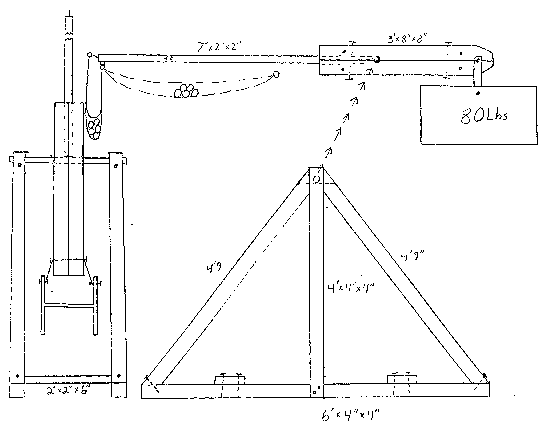The Making
of an SCA Trebuchet
The first thing I would suggest the siege engineer do is go to a
library and find a copy of "The Crossbow", by Sir Ralph Payne-Gallway, Bt.,
published in America by Bramhall House, New York. This book is helpful in
the construction of siege engines and crossbows.
While siege engines like the catapult and balista have been around
since 800 BC, the trebuchet was first commonly used by the French in the
twelfth century. Its ability to cast stones weighing over 300 pounds made
it immensely popular. Seige engines could routinely throw their loads over
400 yards. This placed them well outside the range of an English longbow.
For SCA combat I decided that I needed to be able to throw a load
consisting of eight slitted tennis ball, wrapped in duct tape, a distance
of between thirty and fifty yards, twenty to thirty yards being the '
farthest our Markland arrows would travel. I used a I-beam weighing
approximately 70-80 pounds for the weight, and my throwing arm was about 10
feet long.
The sling and the weight are what give the trebuchet its power. The
sling on the end of a trebuchet makes it twice as powerful as a catapult of
the same size. The sling should be 2/3 the length of the arm when stretched
out. You can change the arc of the missiles by changing the length of the
sling. Shortening the sling makes your missiles fly higher also makes the
distance traveled shorter. Lengthening the sling makes them fly straight
and fast. One end of the sling is attached permanently to the end of the
throwing arm, the other is placed on a hook sticking out of the end of the
arm. The hook should not be straight, as this will cause your missiles to
go straight up, and fall on YOU instead of your enemies.
When we actually used our trebuchet in battle at Gatalop V, we needed
about 10 feet more distance than we were getting. When we moved the
trebuchet forward 10 feet it was on a downward incline which made the
throwing distance even less. We did actually wind up killing someone on the
defending team, but we lost most of our ammunition in the moat. Despite
these problems, we still won the "Best Seige Engine" contest.
Good luck and Happy Seiging!
Lord Thomas of Hudd's Path
12th century Norman

|